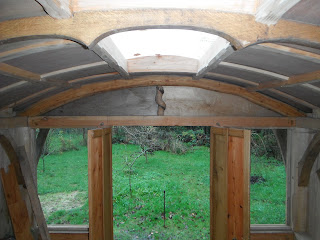This is Upcott Wood, inhabited by Marcus Tribe.
He bought this 2ha woodland 12 years ago with the intension of managing the
woodland and living from the land. After a long battle with the planning
authorities following an eviction notice he eventually gained full planning permission to build a permanent
home on the site, which is currently a work in progress. Below is the 'temporary' yurt which he is currently living in.
His life is very much in the woods and of the woods. Water comes from a well, firewood from the woods, fruit and veg from the garden, electricity from a small solar panel. He has a compost loo and is entirely off-grid. He does use calor gas for cooking but is working on ways of phasing this out in favour of finding a safe way to burn his home made charcoal indoors (as in some Indian restaurants).
His life is very much in the woods and of the woods. Water comes from a well, firewood from the woods, fruit and veg from the garden, electricity from a small solar panel. He has a compost loo and is entirely off-grid. He does use calor gas for cooking but is working on ways of phasing this out in favour of finding a safe way to burn his home made charcoal indoors (as in some Indian restaurants).
The yurt is heated by a small woodburning stove which burns coppice wood from the woodland. Because of the yurt's dome-shaped design & the layers of insulation under the tarpaulin heat circulates within the structure & it is toasty warm 24hrs a day. There is no issue with damp, and Marcus is so comfortable living in it he is in no rush to move into his permanent home.
Here is the permanent house that Marcus is building. It is also based on the design of a yurt as he swears by its shape for thermo-efficiency. The roof is about to be planted up with sedum as a living roof. All of the timber was sourced locally and he has milled it and constructed the building himself to his own design.
A large stove sits in the centre of the building. Marcus is a master at
finding interesting bits of wood & incorporating them into the
building, such as the twisted double forked trunk to the left of the frame.
 | ||||||||
This was my accommodation for the duration of my stay. Again, a tiny woodburner made it warm and cosy.
Marcus built a timber framed workshop. He makes and sells various wooden items such as oak pegs for other timber frame buildings. Adding value to otherwise reject timber is the name of the game. The workshop also functions as a space in which people just drop in to whittle spoons & bowls etc. whenever they feel the need to escape the hussle & bussle of 'normal life'. There is a calm about Upcott Wood that makes it a very appealing place to spend time...
Another structure - the compost loo. He is installing a shower here too which will be heated by his own charcoal...
The permaculture garden - between this and bits he can grow through his 2-day per week gardening job, Marcus is mostly self-sufficient for fruit and vegetables.
Rainwater harvesting for watering the veg.
A coppice coupe within the woodland. This was cut last year (this years firewood). The re-growth from the stools is around 50cm high already. He has also planted a few small trees along side to increase the stool density. This means that as the young trees grow (and re-grow) they push each other up straight as they head for the light. This produces much more useable wood and also shades out undesirable plant species. When the coupe is cut again the light reaching the woodland floor causes a flush of wild flowers that wouldn't otherwise germinate.
Harvesting firewood for next year. I had assumed this tractor was a relic of a bygone age & was quite surprised to see it splutter into life with no trouble at all. Note the blanket in place of the bonnet!
This has been a superb and facinating stay & I've learned loads. It was a real pleasure to spend time with Marcus & I am very greatful for my time here. It was great to see someone live their dream when that dream is so humble - simply to tread lightly and to give back. It proves to me that it is possible to live within a sensible level of consumption and be comfortable even if our government favours attempting to prevent it. In fact Marcus comes across as someone who is not only comfortable but deeply contented, having time to provide for himself, freely give his time to helping others, and still have time to appreciate the world around him in intimate detail.

































